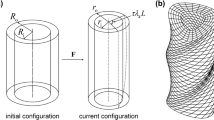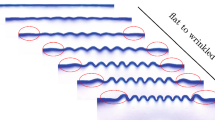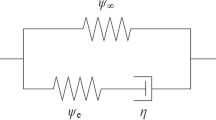Abstract
This work focuses on planar growth-induced instabilities in three-dimensional bilayer structures, i.e., thick stiff film on a compliant substrate or a confined tissue. Growth-induced instabilities are examined in three-dimension for a different range of fiber stiffness with a five-field Hu-Washizu type mixed variational formulation as the first time in the literature to our best knowledge. The quasi-incompressible and quasi-inextensible limits of transversely isotropic materials were considered. A numerical example was solved by implementing the T2P0F0 element on an automated differential equation solver platform, FEniCS. There was proposed a 2D modelling procedure based on a long but thin bilayer plate for the determination of exact wavelengths which plays key role in the periodic boundary condition in 3D plate. It was shown that both the wavelength and critical growth parameter g decrease by increasing the fiber stiffness for the first instability, which is obtained along the stiff fiber direction. The effect of the fiber stiffness is minor on the secondary buckling, which was observed perpendicular to the fiber direction. For a range of fiber stiffnesses, bifurcation points of instabilities were also determined by monitoring displacements and energies. The energy contributions of layers with different ranges of fiber stiffnesses were examined. It is concluded that the energy release mechanism at the initiation of the primary buckling is mainly due to isotropic and anisotropic contributions of the stiff film layer. For high fiber stiffnesses, the effect of the anisotropic energy on the first buckling becomes more dominant over other types. However, in the secondary instability, the isotropic energy of the film layer becomes the dominant one. Numerical outcomes of this study will help to understand the fiber stiffness effect on the buckling and post-buckling behavior of bilayer systems and fiber-reinforced soft biological tissues.















Similar content being viewed by others
Data availability
All calculated data supporting the findings of this study are available within the paper.
References
Mora, T., Boudaoud, A.: Buckling of swelling gels. Eur. Phys. J. E: Soft matter and biological physics, EDP Sciences: EPJ. 20:pp.119 (2006)
Khang, D., Rogers, J.A., Lee, H.H.: Mechanical buckling: mechanics, metrology, and stretchable electronics. Adv. Func. Mat. 10, 1526–1536 (2009)
Rodriguez, E.K., Hoger, A., McCulloch, A.D.: Stress-dependent finite growth in soft elastic tissues. J. Biomech. 27, 455–467 (1994)
Li, B., Jia, F., Cao, Y., Feng, X., Gao, H.: Surface wrinkling patterns on a core-shell soft sphere. Phys. Rev. Letter. 106, 2–5 (2011)
Eskandari, M., Pfaller, M.R., Kuhl, E.: On the role of mechanics in chronic lung disease. Mater. 6, 5639–5658 (2013)
Budday, S., Steinmann, P., Kuhl, E.: The role of mechanics during brain development. J. Mech. Phys. Solid. 72, 75–92 (2014)
Ulerich, J., Göktepe, S., Kuhl, E.: Dilation and hypertrophy: a cell-based continuum mechanics approach towards ventricular growth and remodeling. IUTAM Bookseries 16, 237–244 (2010)
Göktepe, S., Abilez, O.J., Kuhl, E.: A generic approach towards finite growth with examples of athlete’s heart, cardiac dilation, and cardiac wall thickening. J. Mech. Phys. Solid. 58, 1661–1680 (2010)
Göktepe, S., Abilez, O.J., Parker, K.K., Kuhl, E.A.: Multiscale model for eccentric and concentric cardiac growth through sarcomerogenesis. J. Theor. Bio. 265, 433–442 (2010)
Rausch, M.K., Dam, A., Göktepe, S., Abilez, O.J., Kuhl, E.: Computational modeling of growth: Systemic and pulmonary hypertension in the heart. Biomech. Model. Mechano. 10, 799–811 (2011)
Genzer, J., Groenewold, J.: Soft matter with hard skin: from skin wrinkles to templating and material characterization. Soft Matter. 2, 310–323 (2006)
Tepole, A.B., Ploch, C.J., Wong, J., Gosain, A.K., Kuhl, E.: Growing skin: a computational model for skin expansion in reconstructive surgery. J. Mech. Phys. Solid. 59, 2177–2190 (2011)
Taber, L.A.: Growing skin: biomechanics of growth, remodeling, and morphogenesis. Appl. Mech. Revi. 48, 487–545 (1995)
Hariton, I., deBotton, G., Gasser, T.C., Holzapfel, G.A.: Stress-driven collagen fiber remodeling in arterial walls. Biomech. Model. Mechano. 6, 163–175 (2007)
Demirkoparan, H., Pence, T.J.: The effect of fiber recruitment on the swelling of a pressurized anisotropic non-linearly elastic tube. Int. J. Non-Lin. Mech. 42, 258–270 (2007)
Volokh, K.Y.: Prediction of arterial failure based on a microstructural bi-layer fiber-matrix model with softening. J. Biomech. 41, 447–453 (2008)
Sáez, P., Peña, E., Martínez, M.A., Kuhl, E.: Computational modeling of hypertensive growth in the human carotid artery. Comput. Mech. 53, 1183–1196 (2014)
Lubarda, V.A., Hoger, A.: On the mechanics of solids with a growing mass. Int. J. Solid. Struct. 39, 4627–4664 (2002)
Huang, Z.Y., Hong, W., Suo, Z.: Nonlinear analyses of wrinkles in a film bonded to a compliant substrate. J. Mech. Phys. Solid. 53, 2101–2118 (2005)
Brau, F., Vandeparre, H., Sabbah, A., Poulard, C., Boudaoud, A., Damman, P.: Multiple-length-scale elastic instability mimics parametric resonance of nonlinear oscillators. Nature Phys. 7, 56–60 (2011)
Cai, S., Breid, D., Crosby, A.J., Suo, Z., Hutchinson, J.W.: Periodic patterns and energy states of buckled films on compliant substrates. J. Mech. Phys. Solid. 59, 1094–1114 (2011)
Jia, F., Amar, M.B.: Theoretical analysis of growth or swelling wrinkles on constrained soft slabs. Soft Matter. 9, 8216–8226 (2013)
Dervaux, J., Ciarletta, P., Amar, M.B.: Morphogenesis of thin hyperelastic plates: a constitutive theory of biological growth in the Foppl von Karman limit. J. Mech. Phys. Solid. 57:458–471 (20099)
Javili, A., Steinmann, P., Kuhl, E.: A novel strategy to identify the critical conditions for growth-induced instabilities. J. Mech. Behavior Biomed. Mater. 29, 20–32 (2014)
Ionov, L.: Biomimetic hydrogel-based actuating systems. Adv. Funct. Mater. 23, 4555–4570 (2013)
Liu, Y., Zhang, H., Zheng, Y.: A multiplicative finite element algorithm for the inhomogeneous swelling of polymeric gels. Comput. Methods Appl. Mech. Eng. 283, 517–550 (2015)
Liu, Y., Zhang, H., Zhang, J., Zheng, Y.: Constitutive modeling for polymer hydrogels: a new perspective and applications to anisotropic hydrogels in free swelling. Eur. J. Mech., A/Solid. 54, 171–186 (2015)
Nardinocchi, P., Pezzulla, M., Teresi, L.: Anisotropic swelling of thin gel sheets. Soft Matter 11, 1492–1499 (2015)
Nardinocchi, P., Pezulla, M., Teresi, L.: Steady and transient analysis of anisotropic swelling in fibered gels. J. Appl. Phys. 118, 244904 (2015)
Liu, Y., Zhang, H., Wang, J., Zheng, Y.: Anisotropic swelling in fiber-reinforced hydrogels: an incremental finite element method and its applications in design of bilayer structures. Int. J. Appl. Mech. 8, 1640003 (2016)
Wang, J., Qiu, Y., Zhang, H., Zheng, Y., Ye, H.: A solid-shell finite element method for the anisotropic swelling of hydrogels with reinforced fibers. Eur. J. Mech., A/Solids. 86, 104197 (2021)
Liu, W., Rahn, C.R.: Fiber-reinforced membrane models of McKibben actuators. J. Appl. Mech. Trans. ASME. 70, 853–859 (2003)
Fang, Y., Pence, T.J., Tan, X.: Fiber-directed conjugated-polymer torsional actuator: nonlinear elasticity modeling and experimental validation. IEEE/ASME transactions on mechatronics. 16, 656–664 (2011)
Dadgar-Rad, F., Dorostkar, A.N., Hossain, M.: Growth of shell-like soft biological tissues under mechanical loading. Int. J. Non-Linear Mech. in press. (2023)
Kuhl, E., Menzel, A., Steinmann, P.: Computational modeling of growth. A critical review, a classification of concepts and two new consistent approaches. Comput. Mech. 32, 71–88 (2003)
Li, B., Cao, Y.-P., Feng, X.-Q., Gao, H.: Mechanics of morphological instabilities and surface wrinkling in soft materials: a review. Soft Matter. 8, 5728–5745 (2012)
Ambrosi, D., Ateshian, G.A., Arruda, E.M., Cowin, S.C., Dumais, J., Goriely, A., Holzapfel, G.A., Humphrey, J.D., Kemkemer, R., Kuhl, E., Olberding, J.E., Taber, L.A., Garikipati, K.: Perspectives on biological growth and remodeling. J. Mech. Phys. Solids. 59, 863–883 (2011)
Menzel, A., Kuhl, E.: Frontiers in growth and remodeling. Mech. Res. Comm. 42, 1–14 (2012)
Kuhl, E.: Growing matter: a review of growth in living systems. J. Mech. Behavior Biomed. Mater. 29, 529–543 (2014)
Goriely, A.: Five ways to model active processes in elastic solids: active forces, active stresses, active strains, active fibers, and active metrics. Mech. Res. Comm. 93, 75–79 (2018)
Yang, S., Khare, K., Lin, P.-C.: Harnessing surface wrinkle patterns in soft matter. Adv. Funct. Mater. 20, 2550–2564 (2010)
Audoly, B., Boudaoud, A.: Buckling of a stiff film bound to a compliant substrate—part III: herringbone solutions at large buckling parameter. J. Mech. Phys. Solids. 56, 2444–2458 (2008)
Javili, A., Dortdivanlioglu, B., Kuhl, E., Linder, C.: Computational aspects of growth-induced instabilities through eigenvalue analysis. Comput. Mech. 56, 405–420 (2015)
Dortdivanlioglu, B., Javili, A., Linder, C.: Computational aspects of morphological instabilities using isogeometric analysis. Comput. Methods Appl. Mech. Eng. 316, 261–279 (2017)
Audoly, B:. Buckling of a stiff film bound to a compliant substrate (part I). Formulation, linear stability of cylindrical patterns, secondary bifurcations. J. Mech. Phys. Solids. 56, 2401–2421 (2008)
Audoly, B., Boudaoud, A.: Buckling of a stiff film bound to a compliant substrate—part II: a global scenario for the formation of herringbone pattern. J. Mech. Phys. Solids. 56, 2422–2443 (2008)
Alawiye, H., Kuhl, E., Goriely, A.: Revisiting the wrinkling of elastic bilayers I: linear analysis. Phil. Trans. R. Soc. A. Math. Phys. Eng. Sci. 377, 20180076 (2019)
Ilseng, A., Prot, V., Skallerud, B.H., Stokke, B.T.: Buckling initiation in layered hydrogels during transient swelling. J. Mech. Phys. Solids. 128, 219–238 (2019)
Dortdivanlioglu, B., Linder, C.: Diffusion-driven swelling-induced instabilities of hydrogels. J. Mech. Phys. Solids. 125, 38–52 (2019)
Kadapa, C., Li, Z., Hossain, M., Wang, J.: On the advantages of mixed formulation and higher-order elements for computational morphoelasticity. J. Mech. Phys. Solids. 148, 104289 (2021)
Rachev, A., Stergiopulos, N., Mesiter, J.-J.: Theoretical study of dynamics of arterial wall remodeling in response to changes in blood pressure. J. Biomech. 29, 635–642 (1996)
Taber, L.A.: A model for aortic growth based on fluid shear and fiber stresses. J. Biomech. Eng. 120, 348–354 (1998)
Ciarletta, P., Amar, M.B.: Pattern formation in fiber-reinforced tubular tissues: folding and segmentation during epithelial growth. J. Mech. Phys. Solids. 60, 525–537 (2012)
Stewart, P.S., Waters, S.L., Sayed, T.E., Vella, D., Goriely, A.: Wrinkling, creasing, and folding in fiber-reinforced soft tissues. Extreme Mech. Lett. 8, 22–29 (2016)
Agoras, M., Lopez-Pamies, O., Castañeda, P.P.: Onset of macroscopic instabilities in fiber-reinforced elastomers at finite strain. J. Mech. Phys. Solids. 57, 1828–1850 (2009)
Michel, J.C., Lopez-Pamies, O., Castañeda, P.P., Triantafyllidis, N.: Microscopic and macroscopic instabilities in finitely strained fiber-reinforced elastomers. J. Mech. Phys. Solids. 11, 1776–1803 (2010)
Slesarenko, V., Rudykh, S.: Microscopic and macroscopic instabilities in hyperelastic fiber composites. J. Mech. Phys. Solids. 99, 471–482 (2017)
Topol, H., Demirkoparan, H.: Uniaxial load analysis under stretch-dependent fiber remodeling applicable to collagenous tissue. J. Eng. Math. 95, 325–345 (2015)
Lanir, Y.: Mechanistic micro-structural theory of soft tissues growth and remodeling: tissues with unidirectional fiber. Biomech. Model. Mechano. 14, 245–266 (2015)
Gou, K., Pence, T.J.: Hyperelastic modeling of swelling in fibrous soft tissue with application to tracheal angioedema. J. Math. Biol. 72, 499–526 (2016)
Gou, K., Pence, T.J.: Computational modeling of tracheal angioedema due to swelling of the submucous tissue layer. Int. J. Numer. Methods Biomed. Eng. 33, (10) (2017)
Gou, K., Fok, P.-W., Fu, Y.: Nonlinear tubular organ modeling and analysis for tracheal angioedema by swelling-morphoelasticity. J. Eng. Math. 112, 95–117 (2018)
Dal, H.: A quasi-incompressible and quasi-inextensible element formulation for transversely isotropic materials. Int. J. Numer. Methods Eng. 117, 118–140 (2018)
Zdunek, A., Rachowicz, W., Eriksson, T.: A novel computational formulation for nearly incompressible and nearly inextensible finite hyperelasticity. Compu. Methods Appl. Mech. Eng. 281, 220–249 (2014)
Zdunek, A., Rachowicz, W., Eriksson, T.: A five-field finite element formulation for nearly inextensible and nearly incompressible finite hyperelasticity. Comput. Math. Appl. 72, 25–47 (2016)
Logg, A., Mardal, K.-A., Wells, G.N.: Automated solution of differential equations by the finite element method. Lect. Notes Comput. Sci. Eng. 84, 1–736 (2012)
Pian, T.H.H., Chen, D.P.: Alternative ways for formulation of hybrid stress elements. Int. J. Numer. Methods Eng. 18, 1679–1684 (1982)
Pian, T.H.H., Sumihara, K.: Rational approach for assumed stress finite elements. Int. J. Numer. Methods Eng. 20, 1685–1695 (1984)
Nagtegaal, J.C., Parks, D.M., Rice, J.R.: On numerically accurate finite element solutions in the fully plastic range. Comput. Methods Appl. Mech. Eng. 4, 153–177 (1974)
Simó, J.C., Taylor, R.L., Pister, K.S.: Variational and projection methods for the volume constraint in finite deformation elasto-plasticity 51, 177–208 (1985)
Simó J.C., Taylor, R.L.: Quasi-incompressible finite elasticity in principal stretches. continuum basis and numerical algorithms. Comput. Methods Appl. Mech. Eng. 85, 273–310 (1991)
Miehe, C.: Aspects of the formulation and finite element implementation of large strain isotropic elasticity 37, 1981–2004 (1994)
Dal, H., Kaliske, M.: Bergström-boyce model for nonlinear finite rubber viscoelasticity: theoretical aspects and algorithmic treatment for the fe method. Comput. Mech. 44, 809–823 (2009)
Kadapa, C., Hossain, M.: A linearized consistent mixed displacement- pressure formulation for hyperelasticity. Mechanics of advanced materials and structures ISSN 29(2), 267–284 (2022)
Li, Z., Kadapa, C., Hossain, M., Wang, J.: A numerical framework for the simulation of coupled electromechanical growth. Comput. Methods Appl. Mech. Eng. 414, 116128 (2023)
Li, Z., Wang, Q., Du, P., Kadapa, C., Hossain, M., Wang, J.: Analytical study on growth-induced axisymmetric deformations and shape-control of circular hyperelastic plates. Int. J. Eng. Sci. 170, 103594 (2022)
Weiss, J.A., Maker, B.N., Govindjee, S.: Finite element implementation of incompressible, transversely isotropic hyperelasticity. Comput. Methods Appl. Mech. Eng. 135, 107–128 (1996)
Schröder, J., Viebahn, N., Balzani, D., Wriggers, P.: A novel mixed finite element for finite anisotropic elasticity; the ska-element simplified kinematics for anisotropy. Comput. Methods Appl. Mech. Eng. 310, 475–494 (2016)
Wriggers, P., Schröder, J., Auricchio, F.: Finite element formulations for large strain anisotropic material with inextensible fibers. Adv. Model. Simul. Eng. Sci. 3, 1–18 (2016)
Gültekin, O., Rodoplu, B., Dal, H.: A quasi-incompressible and quasi-inextensible finite element analysis of fibrous soft biological tissues. Biomech. Model. Mechano. 19, 2357–2373 (2020)
Raush, K.M., Kuhl, E.: On the mechanics of growing thin biological membranes. J. Mech. Phys. Solids. 63, 128–140 (2014)
Marsdenm, J.E., Hughes, T.J.R.: Mathematical foundations of elasticity. Prentice-Hall, Englewood Cliffs, New Jersey (1983)
Amestoy, P.R., Duff, I.S., L’Excellent, J.-Y.: Multifrontal parallel distributed symmetric and unsymmetric solvers. Comput. Methods Appl. Mech. Eng. 184, 501–520 (2000)
Qiu, G.Y., Pence, T.J.: Remarks on the behavior of simple directionally reinforced incompressible nonlinearly elastic solids. J. Elastic. 49, 1–30 (1997)
Merodio, J., Pence, T.J.: Kink surfaces in a directionally reinforced neo-Hookean material under plane deformation: I. Mechanical equilibrium. J. Elastic. 62, 119–144 (2001)
Merodio, J., Pence, T.J.: Kink surfaces in a directionally reinforced neo-Hookean material under plane deformation: II. Kink band stability and maximally dissipative band broadening. J. Elastic. 62, 145–170 (2001)
Merodio, J., Saccomandi, G., Sgura, I.: The rectilinear shear of fiber-reinforced incompressible non-linearly elastic solids. Int. J. Non-Linear Mech. 42, 342–354 (2007)
Baek, S., Pence, T.J.: Emergence and disappearance of load induced fiber kinking surfaces in transversely isotropic hyperelastic materials. Z. Angew. Math. Phys. 61, 745–772 (2010)
El Hamdaoui, M., Merodio, J., Ogden, R.W.: Two-phase piecewise homogeneous plane deformations of a fibre-reinforced neo-Hookean material with application to fibre kinking and splitting. J. Mech. Phys. Solids. 143, 104091 (2020)
Genet, M., Rausch, M.K., Lee, L.C., Choy, S., Zhao, X., Kassab, G.S., Kozerke, S., Guccione, J.M., Kuhl, E.: Heterogeneous growth-induced prestrain in the heart. J. Biomech. 48, 2080–2089 (2015)
Dadgar-Rad, F., Dorostkar, A.M., Hossain, M.: Growth of shell-like soft biological tissues under mechanical loading. Int. J. Non-Linear Mech. 156, 104505 (2023)
Li, Z., Wang, J., Hossain, M., Kadapa, C.: A theoretical scheme on shape-programming of thin hyperelastic shells through differential growth. Int. J. Solids Struct. 265–266, 112128 (2023)
Author information
Authors and Affiliations
Corresponding author
Ethics declarations
Conflict of interest
The authors declare no competing interests.
Rights and permissions
Springer Nature or its licensor (e.g. a society or other partner) holds exclusive rights to this article under a publishing agreement with the author(s) or other rightsholder(s); author self-archiving of the accepted manuscript version of this article is solely governed by the terms of such publishing agreement and applicable law.
About this article
Cite this article
Altun, C., Gürses, E. & Dal, H. Growth-induced instabilities for transversely isotropic hyperelastic materials. Mech Soft Mater 5, 7 (2023). https://doi.org/10.1007/s42558-023-00055-8
Received:
Accepted:
Published:
DOI: https://doi.org/10.1007/s42558-023-00055-8




